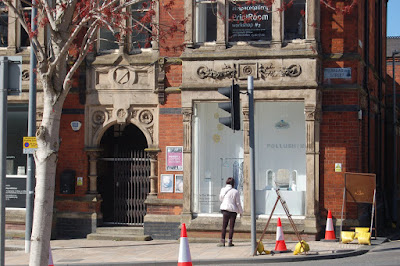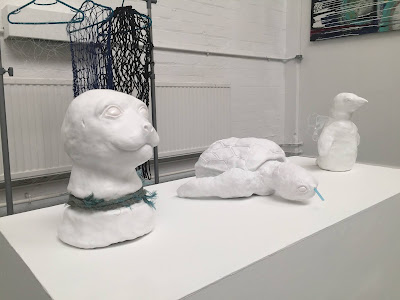I arrived at AirSpace for de-install at 9:30am. Armed with 3 helpers, within 45 minutes - 1 hour it was all down and boxed away. This time working in the opposite order, we started with the elements from the bottom up. Once all the sculptures and supporting works were neatly boxed away we removed the items from the ceiling and filled any holes we made, finishing by touching up the paint on the wall where the sign was.
Reflecting on my time at AirSpace and my first solo exhibition was very emotional. Having this experience has opened up my eyes to life as a working artist, and the jump from University to post-grad in the next couple of years will no longer feel so daunting. From stepping outside my comfort zone and pushing myself, I now have an exciting and promising start to my artist's CV.
During my time at AirSpace I have received a great amount of support and backing through social media outlets like the Gallery's facebook page. Their final post read "Been great to be able to support Staffordshire University's Level 5 Fine Artist Polly Bates with her work "PolluShine - Is It Worth It?" InTheWindow. The work is coming down today but it has some posterity in this piece in the local newspaper - all arranged by Polly herself. With this level of commitment, ingenuity and hard work, we've got high hopes for Polly as she approaches the final year of her degree.". It was elating to receive feedback from someone with so much industry experience, and who I had worked closely with for this project.
For the amount of hard work, commitment and months of preparation it took, the week absolutely flew by. It has been so rewarding, and I was really impressed with what I achieved. Thanks again to everyone who supported, encouraged and guided me through this opportunity, I hope I have many more.
Reflecting on my time at AirSpace and my first solo exhibition was very emotional. Having this experience has opened up my eyes to life as a working artist, and the jump from University to post-grad in the next couple of years will no longer feel so daunting. From stepping outside my comfort zone and pushing myself, I now have an exciting and promising start to my artist's CV.
During my time at AirSpace I have received a great amount of support and backing through social media outlets like the Gallery's facebook page. Their final post read "Been great to be able to support Staffordshire University's Level 5 Fine Artist Polly Bates with her work "PolluShine - Is It Worth It?" InTheWindow. The work is coming down today but it has some posterity in this piece in the local newspaper - all arranged by Polly herself. With this level of commitment, ingenuity and hard work, we've got high hopes for Polly as she approaches the final year of her degree.". It was elating to receive feedback from someone with so much industry experience, and who I had worked closely with for this project.
For the amount of hard work, commitment and months of preparation it took, the week absolutely flew by. It has been so rewarding, and I was really impressed with what I achieved. Thanks again to everyone who supported, encouraged and guided me through this opportunity, I hope I have many more.













































